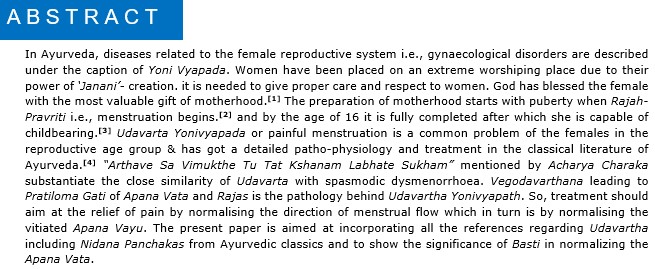An approach towards Pain Management w.s.r. to Udavartini Yonivyapat
DOI:
https://doi.org/10.21760/jaims.8.11.23Keywords:
Udavarta Yonivyapada, Uttarbasti, Kshobha Artava, Vatanulomaka, Menstruation, DysmenorrhoeaAbstract
In Ayurveda, diseases related to the female reproductive system i.e., gynaecological disorders are described under the caption of Yoni Vyapada. Women have been placed on an extreme worshiping place due to their power of ‘Janani’- creation. it is needed to give proper care and respect to women. God has blessed the female with the most valuable gift of motherhood.[1] The preparation of motherhood starts with puberty when Rajah-Pravriti i.e., menstruation begins.[2] and by the age of 16 it is fully completed after which she is capable of childbearing.[3] Udavarta Yonivyapada or painful menstruation is a common problem of the females in the reproductive age group & has got a detailed patho-physiology and treatment in the classical literature of Ayurveda.[4] “Arthave Sa Vimukthe Tu Tat Kshanam Labhate Sukham” mentioned by Acharya Charaka substantiate the close similarity of Udavarta with spasmodic dysmenorrhoea. Vegodavarthana leading to Pratiloma Gati of Apana Vata and Rajas is the pathology behind Udavartha Yonivyapath. So, treatment should aim at the relief of pain by normalising the direction of menstrual flow which in turn is by normalising the vitiated Apana Vayu. The present paper is aimed at incorporating all the references regarding Udavartha including Nidana Panchakas from Ayurvedic classics and to show the significance of Basti in normalizing the Apana Vata.
Downloads
References
Manusmriti with Manuartha Muktavali Commentary of Kulluka Bhatta with Maniprabha Hindi Commentary by Pt. Haragovinda Shshtri; by Pt. Gopala Shashtri Nene. Varanasi: Chaukhamba Surabharati Prakashana; 7th edition, 2001; 9/96:478.
Sushruta Samhita Nibandhasangraha Commentary, Sutra sthana 14/6, by Jadavji Trikamji Acharya. Varanasi: Chaukhamba Surabharati Prakashana; 1st edition, 1994; 59.
Sushruta Samhita Nibandhasangraha Commentary, Sharira sthana 10/53, by Jadavji Trikamji Acharya. Varanasi: Chaukhamba Surabharati Prakashana; 1st edition, reprint 1994; 392.
Charaka Samhita with Ayurveda-Dipika Commentary, Chikitsa sthana 30/25,26, by Jadavji Trikamji Acharya. Varanasi: Chaukhamba Surabharati Prakashana; 1st edition, reprint 2004; 635.
Charaka Samhita with Ayurveda-Dipika Commentary, Chikitsa sthana 30/7, by Jadavji Trikamji Acharya. Varanasi: Chaukhamba Surabharati Prakashana; 1st edition, reprint 2004; 634.
Sushruta Samhita of Sushruta with Nibandhasangraha Commentary, Sharira sthana 3/32, by Jadavji Trikamji Acharya. Varanasi: Chaukhamba Surabharati Prakashana; 1st edition, reprint 1994; 274.
Vagbhata. Ashtanga Hrdayam, English translation by Prof K R Srikanta Murty, Uttarasthana, Chapter 33, verse 33. Varanasi: Choukamba Krishnadas Academy; Reprint 2005; 311.
Agnivesa. Charaka Samhita, Text with English translation by Dr. RK Sharma and Bhagvan Dash, Chikitsa sthana; Yonivyapath cikitsa adhyaya, chapter 30, verse 8. Varanasi: Chaukambha Sanskrit Series; Reprint 2005; 130.
Agnivesa. Charaka Samhita, Text with English translation by Dr. RK Sharma and Bhagvan Dash, Chikitsa sthana; Yonivyapath cikitsa adhyaya: chapter 30, verse 26. Varanasi: Chaukambha Sanskrit Series; Reprint 2005; 135.















